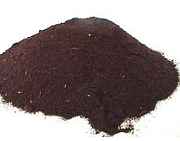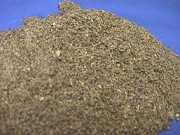Previous Page | Right click this page to print.
Protein Supplements of Animal Origin – Mammalian and Poultry Products
The next three sections will discuss high protein feedstuffs of animal origin. The four classes of feedstuffs are: 1) mammalian-based products such as meat and meat and bone meal; 2) poultry-based products such as hydrolyzed poultry feathers; 3) milk-based products; and 4) marine-based products such as fish meal.
In general, animal-based protein feedstuffs are excellent sources of protein. In comparison to plant-based protein feedstuffs, the amino acid profiles of the animal-based protein feedstuffs more closely match the amino acid profiles required by the animal. One potential issue with animal-based protein feedstuffs is quality. Protein quality will vary by source and also by processing method. The cost is also greater for animal-based protein feedstuffs compared to plant-based protein feedstuffs. In the future, the use of animal-based proteins may decline as a result of quality issues, cost, the availability of synthetic amino acids and vitamins once only available via animal-based protein feeds, and the improved protein quality of plant-based protein feedstuffs.
A regulatory note regarding animal-based products is the species of origin must be stated on the label for many of the products. Further, there are federal regulations regarding the feeding of animal-based proteins. Click on the link to view the original regulations and information regarding feeding: http://www.aafco.org/BSE_aafco_brochure.pdf. Click the following link to view additional, more recent regulations: News Release.htm.
The mammalian-based products described below originate from meat processing and rendering operations.
Meat and bone products include meat meal, meat and bone meal, meat meal tankage, and meat and bone meal tankage.
Figure 7.1 illustrates meat and bone meal.

The products originate from carcass trimmings, condemned carcasses, condemned livers, inedible offal, and bones. Meat meal/tankage and meat and bone meal/tankage are classified based on the phosphorus content. Meals containing greater than 4.4% phosphorus are classified as meat and bone meal/tankage. Meals and tankages are classified according to the inclusion of dried blood; dried blood is not added to meals and is added to tankage. The labels are required to state nutrient content including minimum crude protein, minimum crude fat, maximum crude fiber, minimum phosphorus, and minimum and maximum calcium.
The following is a discussion of the general nutritional value. The nutrient specifications state the maximum amount of feed indigestible by pepsin is 14% and the maximum amount of crude protein indigestible by pepsin is 11%. Pepsin is a protease. The crude protein contents of the various meals and tankages range from 45-60% crude protein on an as-fed basis. The protein qualities of the various products are rated as good to excellent. Data support, the crude protein is digestible. The products are a good energy source; a result of the fat content. The products are also a good source of minerals. The minerals in the highest concentration are calcium at 6-10% and phosphorus at 3-5%; both on an as-fed basis. Meat and bone products are a good source of riboflavin, niacin, and vitamin B12. Meat and bone products are relatively unpalatable.
Meat and bone products contain a number of antinutritional factors. Meat and bone products can potentially cause a calcium and phosphorus imbalance. Improper processing, including inadequate heat-sterilization, can lead to contamination of the products by microorganisms. Improper processing contributed to the transfer of transmissible spongiform encephalopathies (TSE). The most publicized transfer was the transfer across species to cattle. Bovine spongiform encephalopathy (BSE), also referred to as “Mad Cow Disease”, has greatly impacted the bovine industry in Europe and around the world. In December 2003, officials confirmed the first case of BSE in the United States. For more information regarding BSE, click on the link: http://www.fda.gov/oc/opacom/hottopics/bse.html.
Blood meal is dried, ground blood.
Figure 7.2 illustrates blood meal.

Nutritional value is influenced by processing. Flash drying produces the most consistent product. The crude protein content of blood meal is 80-85% on an as-fed basis. Blood meal has an excellent amino acid profile. Blood meal is high in amino acids including lysine, but extremely low in isoleucine. The fiber content in blood meal is low. Blood meal is also low in minerals, with the exception of iron.
Additional mammalian-based products include animal by-product meal, animal digest, animal liver meal, blood protein, fleshings hydrolysate and condensed fleshings hydrolysate, glandular meal and extracted glandular meal, hydrolyzed hair, hydrolyzed leather meal, and dried meat solubles.
Poultry-based high protein products are also fed. Poultry-based products originate from all areas of the poultry industry.
One of the more significant products is hydrolyzed poultry feathers, also referred to as feather meal.
Figure 7.3 illustrates feather meal.

Processing of feathers significantly improves nutritional value. The crude protein content is 85-90% on an as-fed basis. The crude protein must be at least 75% digestible by pepsin. Hydrolyzed poultry feathers are low in methionine, lysine, histidine, and tryptophan. For monogastrics, hydrolyzed poultry feathers are fed in combination with complementary protein feeds. Hydrolyzed poultry feathers are also relatively unpalatable. For monogastrics, amount fed should be limited to 5% of the ration.
Poultry by-product meal is another poultry-based feedstuff. The crude protein content is approximately 60% on an as-fed basis. The specifications state the maximum ash content is 16% and the maximum acid-insoluble ash content is 4%. Poultry by-product meal should be used in combination with other protein sources.
Dried poultry waste and poultry litter are also feedstuffs. The crude protein content of dried poultry waste is 25-35% on an as-fed basis. One-third of the protein is true protein and two-thirds of the protein is nonprotein nitrogen compounds. Poultry waste has a limited amount of fiber. The ash content is 25-30%. Poultry litter has a lower crude protein content at 18-30% and a higher crude fiber content.
Additional poultry-based protein feedstuffs include poultry hatchery by-product, hydrolyzed poultry by-products aggregate, eggshell meal, and poultry by-products.
Previous Page | Right click this page to print.